| ¡@J-PARC News - December 2012 (Issue #93) |
| The Materials and Life Science Experimental Facility (MLF) at J-PARC conducts state-of-the-art experiments in materials and life science using world-class pulsed neutron and muon instruments. In order to develop next-generation researchers and improve the quality of science, we recently held the 1st MLF School for inexperienced graduate students and young researchers with an interest in experiments using neutron and muon beams. When a call was issued for participants, applicants greatly exceeded the capacity, so they were screened, and in the end 24 people participated as students.
On the first day, there was an entrance ceremony, and then students areas radiation-safety training. On the morning of the second day, students were provided with an overview of MLF facilities, and lectures were given on topics such as the JRR-3 neutron source, muon solid-state science, and neutron science. On the afternoon of the second day and the third day, the session was divided into seven exercises (inelastic scattering by neutrons, reflectance, powder diffraction, small-angle scattering, single-crystal diffraction, engineered diffraction experiment, and muon experiment), and training using beams was conducted. For each topic, the supervisor explained the equipment and principle of measurement, and lectured on the training topic, that was followed by measurement training using samples. On the morning of the last day, each group gave a report on its training. Then a school commencement ceremony was held and the students dispersed. Many participants expressed their gratitude for an extremely valuable training experience.
This school was jointly organized by J-PARC, CROSS-Tokai and Ibaraki Prefecture, co-hosted by the KEK Institute of Materials Structure Science, and supported by institutions such as Institute for Solid State Physics of The University of Tokyo. Going forward, we plan to continue the activities of this school as an international school. |
 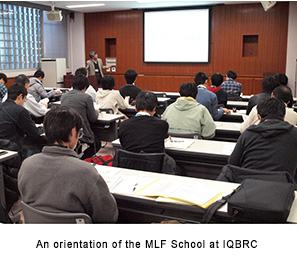 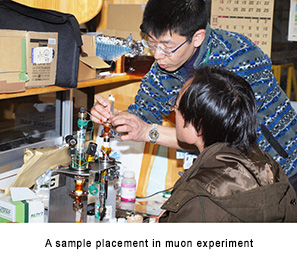 |
 * Click here to enlarge. * Click here to enlarge. |
 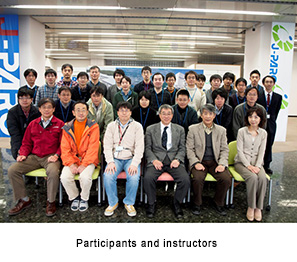 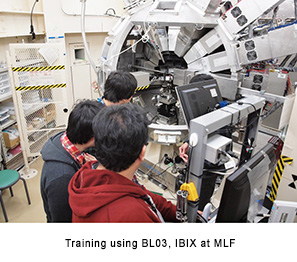 |
 * Click here to enlarge. * Click here to enlarge. |
|
| Considering the Future of the Proton Intensity Frontier - Accelerator Session - on December 20 |
| In the latter half of 2013, J-PARC will increase the energy of its linear accelerator, and install 3 GeV-synchrotron equipment. After that 50 GeV-synchrotron equipment will be installed, and in 2017 we plan to achieve a target beam intensity of 1 MW. However, researchers and other involved parties desire an even higher intensity proton beam in the future. In light of these desires, at this meeting the supervisors of the negative hydrogen ion source, and the 50GeV synchrotron accelerator cavity and electromagnetic source reported on topics, such as the current status of accelerators at J-PARC and the current situation and prospects for basic technology development at each site to achieve future goals. Prospects for research from the user's standpoint were also discussed - in fields such as neutrino physics, hadron physics, muon physics, strange particle physics, K rare decay physics, and physics using static K mesons - and participants passionately discussed topics such as their image of the future of accelerator facilities to enable such research. |

 * Click here to enlarge. * Click here to enlarge. |
| £to Page Top |
|
| Resumption of Operation Using Beams at the Hadron Experimental Facility |
| Experiments using beams were resumed on December 14 after finishing tasks in the Hadron Experimental Facility such as target replacement, adjustment of equipment in each beamline, and assembly of detectors in the KL beamline. Proton beam intensity was raised to 11 kW, and beam quality was improved. On the K1.8 beamline, researchers are gathering data in the E10 Experiment which aims to produce neutron-rich hypernuclei. |
|
| Update Status of Other Experimental Facilities |
| For the linear accelerator, 25 later stage accelerators (ACS) are being fabricated, with the goal of finishing by the end of March 2013, and 21 of these were delivered on December 6. For the Materials and Life Science Experimental Facility, the fourth mercury target vessel was completed and delivered on the 21st. This is the segmented type with a flange part and target vessel part. In the T2K Experiment being conducted at the Neutrino Experimental Facility, operation with a beam-intensity of 210 kW began on the 10th, and on the 11th a new record was achieved for the number of protons supplied in the beam in a single day. |
 |
| £to Page Top |
|
| Shoji Nagamiya, Former Director of the J-PARC Center, Receives First Tokai-mura Community Honorary Award |
| Shoji Nagamiya, former Director of the J-PARC Center, received the first Community Honorary Award in Tokai-mura, together with Ryuichi Terakado, professor emeritus at Ibaraki University. The awards ceremony was held on December 6, at the Tokai-mura Village Office, and the certificate of commendation and commemorative gift were presented by Tatsuya Murakami, Mayor of Tokai-mura. Dr. Nagamiya received this award to recognize his accomplishments and ensure they are remembered by future generations. His accomplishments include, as the first Director of the J-PARC Center, overcoming many difficulties in finishing construction of J-PARC in Tokai-mura that is one of the world's leading facilities for advanced scientific research. It is also acknowledged the fact that J-PARC has not only contributed to the progress of science and technology in the 21st century, but also given hopes and dreams for the future to Tokai-mura. |
|
| 12th Annual Meeting of the Japanese Society for Neutron Science |
| On December 10-11, the 12th Annual Meeting of the Japanese Society for Neutron Science was held at Kyoto University. There were about 250 participants. On the first day, there was an awards ceremony for the various awards presented by the society for 2012, and the awardeesf lectures were followed. Among these, the Society Award was presented to J-PARC Center Adviser, Kazuhisa Kakurai (Director General, Quantum Beam Science Directorate). Many other awards were received by persons involved with J-PARC and researchers who have used neutron beamlines of J-PARC/MLF, thus demonstrating that J-PARC is the center of research in neutron science in Japan. |
 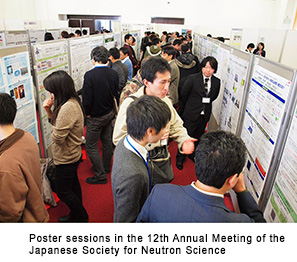  * Click here to enlarge. * Click here to enlarge. |
| On the second day, there were 24 oral presentations, including talks on industrial applications, lectures by young researchers, and general lectures. Of these, 11 related to research results by J-PARC/MLF. At the same time, there were 127 poster presentations. In recent years, there have been high expectations for industrial applications such as "development of new functional materials and high-performance materials" based on experiments using neutrons, and thus as an incidental event at this meeting, a "Consultation Desk on Industrial Applications of Neutrons" was set up, and a "Seminar on Industrial Applications of Neutrons" was held, to broaden understanding of industrial applications of neutrons among people in industry. |
| £to Page Top |
|
| List of Awardees of J-PARC Center Members |
| «The Japan Society for Neutron Science award» |
| ♦ Dr. Kazuhisa Kakurai, Adviser of the J-PARC Center and Director General of Quantum Beam Science Directorate "Investigations of Low-Dimensional and Quantum Spin Systems and Polarized Neutrons" |
| «Technology prize» |
| ♦ Prof. Toru Ishigaki and Assistant Prof. Akinori Hoshikawa of Frontier Research Center for Applied Atomic Sciences, Ibaraki University, and Dr. Masao Yonemura of J-PARC/KEK "Sample-exchange robot available on iMATERIA (the Ibaraki materials design diffractometer) " Drs. Yoshiji Yasu, Kazuo Nakayoshi and Hiroshi Sendai of KEK "Development of DAQ Middleware and Its Installation for Neutron Experiments" "Development of DAQ Middleware and Its Installation for Neutron Experiments" |
| «Encouraging prize» |
| ♦ Dr. Yohei Onodera, Office of Society-Academia Collaboration for Innovation, Kyoto University "Structural Evidence for High Ionic Conductivity of Li7P3S11 Metastable Crystal" |
|
Copyright 2011 JAEA and KEK Joint Project. All rights reserved.
|
|